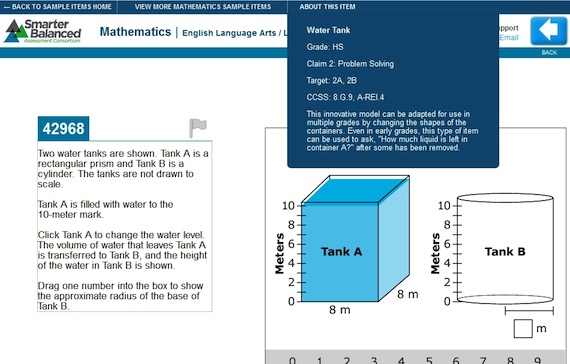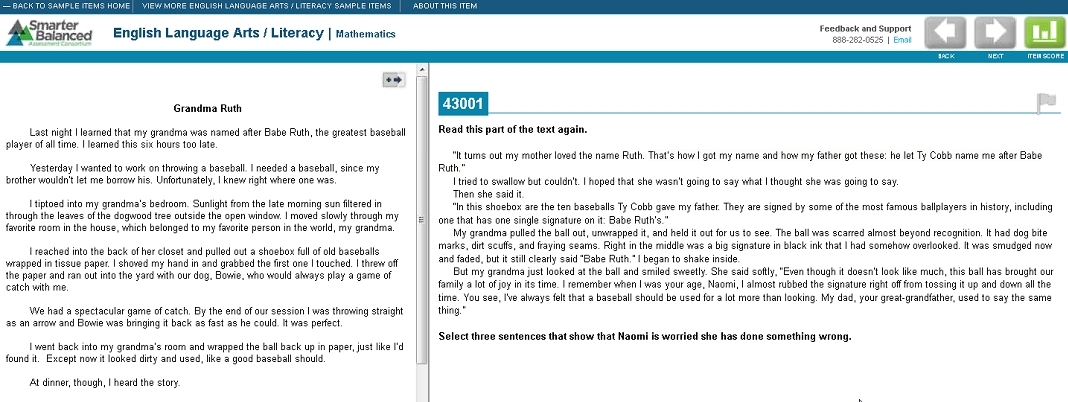Assessment | News
Online Common Core Test Items Released by Smarter Balanced Consortium
- By Dian Schaffhauser
- 10/10/12
The Smarter Balanced Assessment Consortium released a sizable sampling of online assessment items, giving teachers, educational leaders, and members of the public an early look at what kinds of items and tasks will appear on the high-stakes tests that are due to debut in the 2014-2015 school year. Smarter Balanced is one of two consortia issued grants from the United States Department of Education to develop an assessment system that aligns with the Common Core State Standards. The other consortium, Partnership for Assessment of Readiness for College and Careers (PARCC), shared its samples in August.
The stated goal of both the Common Core and the new online assessments is to help students in grades 3 through 12 become better prepared for post-secondary success in college or career. Smarter Balanced's assessments will be used in 25 states, representing about 40 percent of all K-12 public school students.
Smarter Balanced also released performance tasks, which are described as "extended classroom-based activities" that students will also be expected to tackle as part of its assessment system.
Eventually, the sample will grow to include 10,000 items and performance tasks for a pilot test, scheduled to take place February through May 2013. The total item set is expected to have 40,000 items.
"The Smarter Balanced sample items and performance tasks provide an advance look at the types of questions students will encounter when the assessments are implemented in the 2014-15 school year," said Joe Willhoft, executive director of the organization. "Educators can use them to begin planning the shifts in instruction that will be required to help students meet the demands of the new assessments."
Item types include:
- Selected response, the more traditional multiple choice, true-false, and yes-no questions;
- Constructed response, in which students produce a response by using the keyboard or dragging a mouse;
- Technology enhanced, where items use animations in presenting the information or require students to manipulate materials on the screen to either understand the question at a deeper level in a simulation situation or to respond to an item, such as through drag and drop; and
- Performance tasks, scenario-based questions focusing on a single real-world circumstance or situation, requiring students to do deeper thinking to draw upon connections across various subjects and ask them to apply their skills to solve more complex problems.
There are 16 English Language Arts tasks in the sample, such as the rewriting of text excerpts to correct errors or identify extraneous information, highlighting and writing of text to support conclusions or prove a point, and reading of text to answer multiple choice questions. Two ELA questions show a video and ask the students to answer a question using details shown in the movie clip to support their answers. Where writing is required, the question includes a textbox into which the student types an answer.
Mathematics has 25 samples, several of them with multi-part questions. These include animations in which students control the variables in the question being answered, and others where the student performs drag and drop activities. Some items include a small calculator on the screen to help the student with the equation. Others require the student to type in an explanation for how he or she solved the problem.

Sample mathematics question from the forthcoming Common Core online assessments. |
Each question includes an "About this item" pop-up that provides meta-data about the item, including grade level, assessment information, the specification from the Common Core Standard, and comments about the item that are designed to help teachers understand why it was chosen for the sample set. Items using a rubric display those details in a PDF form.
Most of the selected-response and technology-enhanced items can be automatically scored to provide instant feedback to the test-taker. The other item types will be hand-scored, said Willhoft, akin to the way that exams are scored for professionals such as lawyers or certified public accountants. "We don't want to sacrifice quality, of course," he said. "Quite frankly, there are some items that computers cannot score."
The sample also includes six different performance tasks, which are displayed in multi-page PDF documents. These, according to Willhoft, may take upwards of one to two hours to work on, "perhaps across multiple testing sessions," and ask students to respond to a number of questions or scenarios.
"Performance tasks ask students to research and analyze information, weigh evidence, and solve problems relevant to the real world, allowing students to demonstrate their knowledge and skills in an authentic way," added Linda Darling-Hammond, professor of education at Stanford University and senior research advisor for the consortium. "The Smarter Balanced assessment system uses performance tasks to measure skills valued by higher education and the workplace--critical thinking, problem solving, and communication--that are not adequately assessed by most statewide assessments today."

Sample English/language arts question from the forthcoming Common Core online assessments. (Open image in new window to view full-size.) |
Smarter Balanced noted that the current crop of samples run on a simulated test platform that lacks accessibility tools and accommodations options that will be available through the operational assessment system. Those options will include Braille, translation options, and the ability to change font size, highlight text, or magnify portions of items.
The sample items and performance tasks can be accessed from the Smarter Balanced Web site at smarterbalanced.org/sample-items-and-performance-tasks.
About the Author
Dian Schaffhauser is a former senior contributing editor for 1105 Media's education publications THE Journal, Campus Technology and Spaces4Learning.